Following Business Insurance’s 2023 World Captive Forum, an article was written about our SVP, Prabal Lakhanpal‘s session on how captives can be a solution to the changing property insurance market. During which he was quoted on tactics employers can take to help control coverage gaps. Check out the full article here.
As seen on Alera Group’s Insights Page
In the cyclical market for Property and Casualty Insurance, we are more than a year into hard-market conditions, leading growing numbers of businesses to consider alternative risk funding. That, in turn, has created an abundance of work for insurance actuaries and Captive Insurance consultants.
OK, that’s a lot of insurance speak for one paragraph. Let’s unpack:
— A hard market for insurance is characterized by a rise in rates, a reduction in options for coverage, heightened scrutiny by policy underwriters and reduced carrier capacity for coverage limits. A combination of catastrophic weather events and so-called “nuclear verdicts” in liability lawsuits — as well as the cyclical nature of the Property and Casualty (P&C) Insurance market — were the driving forces behind the hardened conditions before the onset of COVID-19, and the pandemic exacerbated matters. Rate increases have leveled off to some extent in 2022, but, in general, most conditions in the market remain unfavorable to consumers.
— Alternative risk funding — also known as alternative risk financing or alternative risk transfer — is a mechanism for providing coverage by means other than commercial insurance. Types of alternative risk funding include Captive Insurance programs, in which a business or group of like businesses creates and funds its own private insurance company to cover one or more risks in the realms of both P&C and employee benefits. Workers’ Compensation, General Liability, Auto, Professional Liability and Medical Stop-Loss are the more common coverages to start with when insuring through a captive, but captives often expand into a funding mechanism for many of an organization’s other lines of insurance, including Cyber and Umbrella (also known as Excess Liability Insurance).
— Insurance actuaries use math, statistics and financial models to analyze the cost of risk and determine how much money a company should pay to protect itself against risk. All insurance carriers employ actuaries to help set policy premiums and limits. Some insurance agencies work with actuaries to negotiate policy details with carriers or, in a captive arrangement, to determine a premium that will cover claims and, in the long term, reduce the insured’s total cost of risk. Captives have the advantage of also building up retained earnings over time and allowing companies to take on more risk, generating additional insurance cost savings for the parent. Among multiple P&C capabilities, actuaries who work with or for an agency also educate clients on the cost of risk and how to manage it.
Now that we’ve cleared that up, let’s talk about the role of an actuary in managing the cost of risk and protecting your business with a customized insurance program — whether you’ve chosen to pursue alternative risk funding or not.
Why an Alternative Solution? And Why Now?
Business leaders know all too well about the hard market for Property and Casualty Insurance. Just as the pandemic began to wane early in 2022 and there were some signs of casualty rate increases leveling off, Russia’s invasion of Ukraine escalated supply-chain disruption and fuel shortages, accelerating the rise in economic inflation. Damage resulting from Hurricane Ian only made matters worse, of course, driving reinsurance — insurance for insurers — into what the Bank of America termed a “true hard market” of its own, with rising costs getting passed on to consumers. These issues have led to overall increases in U.S. P&C industry combined ratios over the past few quarters, sparking further rate increases for certain lines.
It’s no wonder more organizations are looking at captives and other alternative risk-funding solutions.
“Overall, between 2017 and 2021, captives added $4.3 billion to their year-end surplus while returning $5.8 billion in stockholder and policyholder dividends, representing $10.1 billion in insurance cost savings over purchasing coverage from commercial market third parties.”
“The number of U.S. captives continues to rise, although the growth of captive formations was tempered by the onset of economic uncertainty resulting from the pandemic, as well as ongoing scrutiny from the IRS and greater regulatory and reporting requirements.”
“However, these adverse conditions can serve to highlight the benefits of the captive segment and provide businesses an incentive to establish them,” said Fred Eslami, associate director, AM Best.
“‘This current environment allows captives to customize coverage for risks that may be uncommon or difficult to write or place in the standard market,’” Eslami said.
The growth in Captive Insurance has led to an increasing willingness on the part of carriers to work with captives and regard them as partners rather than threats, increasing options for captive solutions. And even if an organization in the end chooses to forgo alternative risk funding – either for an entire P&C program or for individual coverages, such as cyber or commercial umbrella – simply exploring an alternative and having it as an option can improve its position in the insurance market.
Actuary Capabilities: Your Data, Your Future
For insurance agents and brokers, designing an insurance program tailored to your industry and company is as much art as it is science. Working with an actuary enables you to incorporate greater amounts of empirical evidence into evaluating risks and determining insurance solutions: Here’s what the numbers demonstrate about your situation now, and here’s what our analysis shows about how you’ll perform using this solution.
While any good broker will work to design an insurance program customized for your business, a broker working with an actuary will be especially well-equipped to design a solution tailored to your unique needs and goals. Among the key issues an actuary can help brokers work through are:
- Determining appropriate retention/deductible levels to help the client reduce the total cost of risk;
- Estimating client retained unpaid claims liabilities at quarter/year-end;
- Estimating carrier letter-of-credit need for a large deductible program;
- Estimating possible retained loss outcomes at various confidence levels;
- Performing a captive feasibility study.
Many brokers work in silos, taking a vertical approach in evaluating risk based on industry. Actuaries generally don’t distinguish by industry; they analyze across various industries, focusing on each individual client’s loss history (including frequency and severity), claim status, policy details, exposures and risk-control program before determining financial projections for the organization. Taking the long-term view allows for consideration of fluctuations in company and market performance over a period of time, and increases the likelihood of long-term savings and profits.
Optimizing Your Insurance and Benefits Solutions
As companies grow, they generally reach a point where their claims experience is predictable across one or more lines of coverage. Able to determine such predictability, an actuary can then help you:
- Minimize your total insurance spend, directing more money to the coverage your business needs the most.
- Reduce spending on the risks you have under control. This is where alternative risk funding becomes viable.
If you’ve reached the point where your business is paying, say, $100,000 to $250,000 in annual premium, a group captive might be the best solution because you probably aren’t yet structured appropriately to meet the insurance tests required to form a single-parent captive and the economies of scale may not be there for a single-parent captive solution. In such a case you may need to diversify your risk with other organizations (heterogeneous or homogeneous) — in a group captive or in a shared-risk pool solution utilizing reinsurance — for at least the time being.
The bigger, more complex, more diversified a company becomes, the more a fully funded, single-parent captive emerges as an optimal solution in which the business is insuring only its own risk. A single-parent captive also allows for more coverage flexibility and transparency than a group captive program. Quite often, both benefits and P&C risks are insured by a single-parent captive.
What drives the decision to move from traditional, carrier-based insurance to a captive program is savings and, ultimately, return on investment (ROI). How? By moving expenditures that create carrier profits into the captive solution. Captives are highly efficient, with very low expense ratios, unlike carriers. Free from providing a carrier with underwriting income and investment income on held reserves, you’re able to retain this income to ultimately generate a profit and facilitate an insurance mechanism that competes with the commercial market.
An Organization-Focused Approach
In taking an organization-focused approach toward financial analysis, actuaries look not only at funding for Property and Casualty Insurance but also at spending on employee benefits. Most captive insureds will see annual savings between 10% and 40% for premiums that flow through a captive instead of the commercial market.
As we approach the end of the year, Alera Group invites you to the final event in our 2022 Engage series of employee benefits webinars, A Look Ahead to 2023: Hot Topics and Trends. Join us on Thursday, December 15 as we discuss benefits financial officers and HR professionals need to think about now — including alternative solutions — as they plan for the year ahead.
ACCESS ALERA’S WEBINAR HERE
Captive International has released the winners for the 2022 US Awards. Spring is proud to announce that our company and our Managing Partner, Karin Landry were selected as winners for Best Feasibility Study Firm and Best Feasibility Study Individual (respectively). We were also highly commended for Best Actuarial Firm, Best Individual Feasibility Study (Prabal Lakhanpal) and Best Actuary (Peter Johnson).
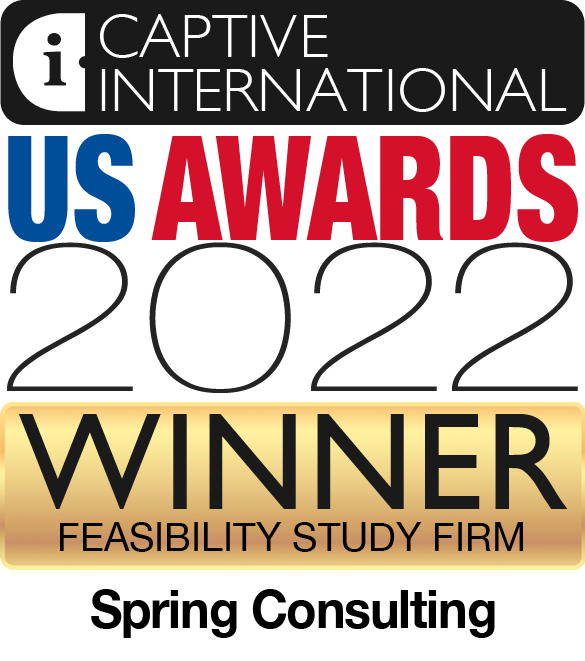

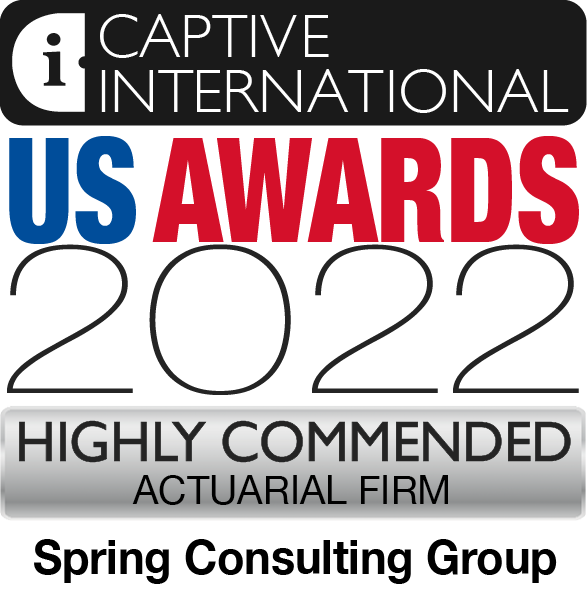
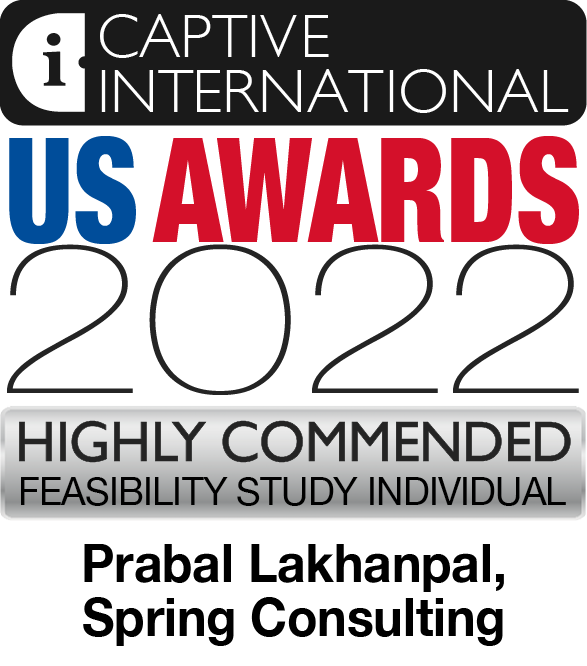
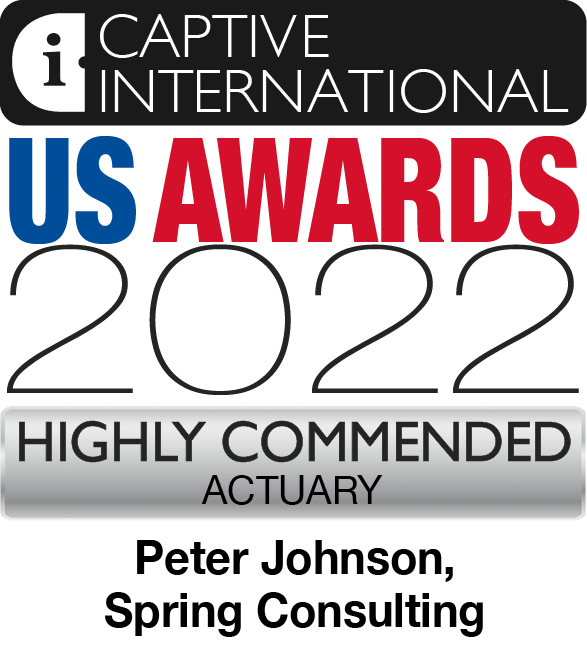
A (Brief) VCIA Session Recap
I had the pleasure of speaking at Vermont Captive Insurance Association (VCIA) Annual Conference last week, joined by two colleagues with impressive backgrounds. Jeff Caudill, Director of Risk Management at Haskell and a client of Spring’s, and Mary Ellen Moriarty, Vice President, Property & Casualty at College Insurance Company (EIIA) joined me to discuss different ways that captives can be used to tackle the hard market hurdles we’re currently facing in the insurance industry.
With myself as the moderator and consulting actuary, Jeff representing a brand new single parent captive, and Mary Ellen representing a veteran captive, it was a well-rounded panel that pulled in multiple perspectives.
The Clouds Behind the Hard Market
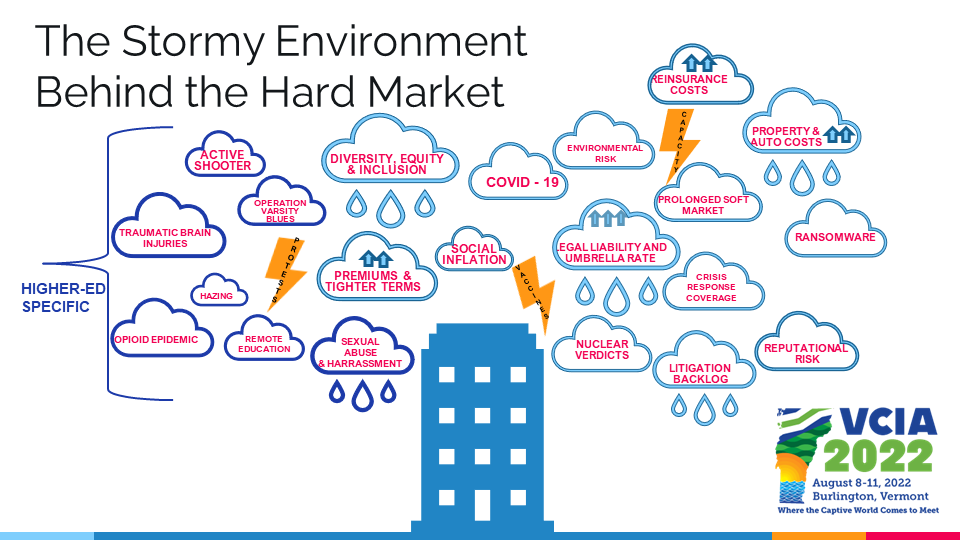
This visual does a great job at illustrating the many challenging atmospheric effects in the insurance air right now, particularly on the property & casualty (P&C) side of the fence (no pun intended). With Mary Ellen representing the higher education space, we felt it important to highlight unique risks that colleges and universities are grappling with, in addition to the other complicating factors (or clouds) we see here.
In my work I’ve seen that this climate has resulted in increased carrier profitability for certain lines over the last couple of years, such as auto liability, but decreased carrier profitability in others (such as cyber and commercial property).
In higher education, Mary Ellen explained there have been hard market consequences due to underwriter inability to achieve profitability, and as noted in the visual, they are dealing with risks many organizations don’t need to think about, like traumatic brain injuries, the general public accessing the property, and a different kind of medical malpractice. As a result, there are a limited number of carriers willing to provide coverage in this space. As a nod to captive advantages, EIIA was able to grow surplus from their captive prior to the hard market, from 2002 to 2022, which has been extremely helpful in this “stormy environment.”
This success story led us to a discussion around the business case for captives, a snapshot of which you can see here in this video.
Jeff then gave a bit of a play-by-play regarding the process, implementation, timelines and driving forces behind Haskell’s decision to switch from a group captive to a single parent captive (a synopsis of which you can find in this case study).
Looking Ahead
Both Jeff and Mary Ellen described some next steps for their captives, which may include writing in:
- Integrated deductible plans
- Directors & officers
- Cyber
- Employee benefits
- Other P&C lines
Food For Thought
Like most good things in life, you kind of had to be there to get the full experience and maximize your take-aways. So I don’t want to give it all away, but I will leave you with some food for thought that came out of the Q&A for the session. If you want to know the answers, please get in touch!
- With a newer captive that hasn’t had time to build up surplus yet, how do you think about keeping your captive adequately capitalized?
- What are the next coverages or exposures you see on the horizon for higher ed that you would like to add to the captive program?
- What were the key drivers for your CFO to be on board to establish the captive?
- Can you talk about how reviver statutes have impacted obtaining/maintaining abuse coverage?
- As we face uninsured risks like communicable disease, how do you assess the use of the captives together with unique insurance solutions like parametric options? What is the value pitch to the organization?
- What type of coverages perform well in the hard market and why?
- Does forming a captive in a hard market only make financial sense if your company’s loss ratio is below the industry average?
- How do you handle cyber in a captive? Do you have a TPA on retainer?
- Are you using the captive for deductible reimbursement? Do you take any quota share or excess layer risk?
- What does your auto exposure look like and what risk mitigation strategies have you implemented (via the captive or otherwise)?
- How do you market your captive to new members who may not understand captives? Especially in light of the hard market, where captives are especially attractive.
And last but perhaps most importantly:
- What do you think the impact to the insurance market will be if the Browns win more than 2 games this year?
As you can see, we can have some fun in the captive world, and much of it was had at VCIA! Before you leave, check out our captive business case video here, inspired by this presentation.
Our Chief P&C Actuary, Peter Johnson participated in a panel discussion at the Vermont Captive Insurance Association (VCIA) Annual Conference on hard-hitting solutions to hard market concerns. Check out this article in Captive International which summarizes key points of the discussion.
The Challenge
A mid-sized (over $1B in annual revenue) architecture, engineering, construction and consulting firm was utilizing an industry group captive to underwrite their workers’ compensation, general liability, automobile coverages and subcontractor default risks. The organization requested Spring to help assess whether the group captive solution was still optimal and to help shape their risk management strategy. As part of this review, we assisted them in considering the pros and cons of exiting the group captive program to form their own single parent captive. To support this decision, we helped them understand both the financial implications and qualitative factors they should contemplate and the implications of this change.
The Process
Spring began by undertaking a total cost of risk assessment at the line of business level for workers’ compensation, general liability, excess general liability, professional liability, subcontractor default, and medical stop-loss insurance lines. The purpose of the study was to explore the universe of options available to the client and included a high-level review of potential risk structures, retention levels, domicile options and reinsurance/fronting options. In addition, Spring commented on the competitiveness of the existing framework, generating a robust view of the advantages and disadvantages of the different solutions, and provided recommendations as to how best to move forward.
Spring’s Solutions
Spring implemented a multi-step approach that included the following:
- The Quantitative Analysis: Creating a total cost of risk comparison between the previous group captive and proposed single parent captive structures for each line to understand program cost savings. The key steps include:
- Analyzing loss and exposure data
- Developing expected claims at various retentions
- Defining operating cost assumptions (other than retained loss)
- Modeling captive company Proforma balance sheet and income statement
- Estimating captive capital requirements
- Obtaining brokerage quotes at the analyzed client retention levels to determine optimal retention level and the anticipated market savings that go with it
- The Qualitative Analysis: Evaluating non-financial factors such as risk distribution, domicile, regulations, administrative requirements and the positives and negatives for each captive solution. The key steps included:
- Evaluating the required structure to meet appropriate insurance tests, like risk shifting and risk distribution
- Evaluating differences between the home state and other potential domiciles
- Conducting a deep dive into the various service provider functions and requirements
- Completing a policy review to outline potential changes to coverage terms with a single parent captive
- Providing a pros and cons analysis for a single parent captive versus the current group captive structure. Some of the benefits of each are as follows:
- A single parent captive model allows additional flexibility in coverage option including medical stop-loss, more control over funding structure and selected services and risk control programs, and the ability to take full advantage of a favorable long-term loss profile
- The original group captive structure offers favorable pricing over commercial markets for certain lines in the near term due to large, self-insured retentions and economies of scale by mixing in the risk of other large insureds with similar risk profiles. It also allows access to certain safety management and other services (if desired)
- Reporting of Results: Preparing and presenting a report highlighting the financial and non-financial differences to enable the client to make a fully-informed decision to either move forward with implementation or stay with the existing captive.
- The Client Decision: After thorough fact finding, analysis and comparisons, and communication with the client, the decision was made to form a Vermont-based single parent captive. To move the process forward, we created an actuarial captive feasibility study, a captive business plan, policy forms and other documents to be submitted to the Vermont regulators. There was initial uncertainty over whether the client would still receive required risk distribution, as there was a change in the third-party risk profile with a single parent captive. However, the accounting and tax team concluded that the new entity, based on the selected coverage structure and underlying insured exposures, still qualifies for risk distribution and can be treated as an insurance company
- Next Steps: Spring began quarterbacking the client through the implementation process once they decided to form their Vermont single parent captive, which involved the following:
- Preparing an actuarial captive feasibility study and worked with the selected captive manager on the application material for submission to the Vermont department of insurance
- Assisting in the selection of service providers for the captive
- Providing ongoing actuarial and consulting services to the parent company and their captive to ensure that they are aware of all possible insurance solutions available and are informed in their insurance choices
Ongoing Success
In the current challenging market conditions, a captive solution is a powerful tool to have during renewal negotiations. Even if it isn’t implemented immediately, having the captive option available provides a competing solution to traditional carriers. Even for coverages not insured through the captive, the client will have increased bargaining power and may receive better offers from traditional insurers. Most importantly, moving from a group captive to a single parent captive has provided the organization the opportunity to use a captive solution to support other aspects of their business. For instance, by adding medical stop-loss to the captive, they will be able to generate additional savings for the HR teams, allowing increased support for employee wellbeing and resources to implement additional wellness initiatives.
In summary, the client chose the solution that provides them flexibility, over maintaining the status quo of their group captive, and enables the parent company a recoup of profits, particularly as it builds surplus over time, that would otherwise go to the group captive and excess carriers. As the captive matures, the client is also expected to receive captive profits back as dividends and be able to further increase self-insured retentions. We will continue to provide insurance consulting (both captive-related and beyond) to the parent company and lead them through the initial year of single parent captive strategies.
In April of 2022, the Bureau of Labor Statistics reported that inflation hit a staggering 8.5%. If current projections hold true, this year will have the highest inflation rate since 1981. COVID-19, supply chain problems, Russia’s invasion of the Ukraine, housing price increases, and more predictable market cycles are some of the driving forces behind such high inflation. In our line of work – insurance, risk management, and employee benefits – macroeconomic factors like these are seen in the challenges our clients face and the solutions they prioritize. To complicate things, the property and casualty realm is also subject to things like natural disasters, climate risk, changes in societal litigiousness, and ransomware/cyber risk. That said, we sat down with Peter Johnson, Spring’s Chief Property & Casualty Actuary, to discuss how this challenging environment interplays with his work in the captive insurance space.
Q: Is inflation having an impact on underwriting and pricing?
A: This is case-by-case between captives but as an overall average, yes. A captive in a strong surplus position and favorable historical loss experience will still be able to provide favorable pricing even when the industry is seeing high loss trend and rate increases. Higher frequency and/or severity trends are certainly still impacting pricing needs for certain lines, such as cyber and excess liability where experience isn’t frequent in nature and the credibility of a single company’s experience is low. Specifically for cyber, ransomware loss costs have grown exponentially over the last 3 years and rate increases are being observed by both commercial carriers and captives. Further for both cyber and excess liability where commercial market pricing issues exist capacity has also shrunk and captive are being looked to, to fill the gap.
Q: Is inflation currently impacting reserving and if not, do you think it will in the future?
A: In general, yes, for many casualty lines where loss trends are high or increasing, but this is also a case-by-case basis since captives with good data credibility and stable historical loss experience can respond to their actual loss development and may not have a need for much, if any, reserve increases due to inflation. Cyber liability, commercial auto liability and excess liability are three lines in the industry with increasing severity trends and captive reserving practices often consider industry trends when company experience isn’t fully credible by itself, so I would expect some reserve strengthening for these lines due to trend assumption increases. Supply chain issues have been an obvious issue in the used car market and depending on a captive’s auto exposure and experience, there may be both increasing auto rate levels and reserve levels for the captive.
Q: Some analysts have suggested that while commercial market insurers are concerned about inflation, the impact might be offset to some extent by the benefit of higher interest rates in their investment portfolios. Would you expect captives to realize a similar investment benefit? Would you expect it to be significant?
A: To the extent a captive’s investment portfolio is invested in higher yielding fixed income, securities or other investments that are inflation sensitive then yes, there would be some offset.
Q: Are there specific coverage lines in captives that will be more affected by inflation than others?
A: Cyber, excess liability/umbrella and auto liability have seen higher trends than workers’ comp. Geography is an important factor as well since certain areas have seen noticeably higher/lower trends than the industry average. For example, medical professional liability severity trends have increased, but this varies significantly by region. Some states are seeing double digit severity trends and rate increases while others are experiencing very modest increases. Difference in litigiousness and jury awards drive much of these state-by-state differences. Property is certainly impacted by inflation with increases in cost to build, but natural catastrophes such as hurricanes, wildfire and wind/hail have typically had more of an impact and to compound things the current supply chain and inflation issues immediately after a disaster can lead to even costlier natural disasters. According to NOAA National Center for Environmental Information 2021 came is second all-time with 2020 coming in first as far as the total number and total cost of these disasters.
Q: Would you anticipate any changes in captive strategies in response to inflation?
A: For captives with active investment advisors, I’d expect a response on the investment side depending on their current investment profile and the surplus and loss reserve position of the captive. There certainly could be a variety of responses on the insurance risk side, particularly if inflation is driving up claim severity and significantly changing the risk profile of a captive. Capitalization, limits, retentions, reinsurance, and pricing are all potentially impacted and would need to be considered.
Q: Is there any advice you’d offer captive owners regarding inflation strategy?
A: In general, it is important to sensitivity test your proforma projections every few years based on practical adverse loss outcomes and investment income scenarios. These financial projections can consider higher than anticipated inflation trends over a multi-year projection horizon. This will help determine appropriate captive capitalization levels, reinsurance, pricing, and risk margin to protect against possible adverse events.
Q: Any final thoughts on the subject?
A: Firstly, large jury awards remain top of mind for many company executives and boards. Although the impact on industry combined ratios is less obvious based on what I’ve seen, this continues to be a big concern and is part of the driving force behind pricing increases in the commercial market for certain liability lines.
Secondly, as carrier capacity presumably decreases and underwriting profit margins increase for certain carrier lines where rate level increases outpace loss trend, captives will continue to be utilized to insure more risk and recoup underwriting and investment income related profits otherwise going to commercial carriers.
There you have it. While there are many negatives that sprout from inflation, one positive is that it allows captives to continue to elevate their status as a strategic risk management and financial tactic for organizations of all kinds, and help companies better face the difficult economic climate.
A recap of a presentation by Peter Johnson of Spring, Deyna Feng of Cummins, and Melissa Updike of KMRRG at the VCIA 2021 annual conference.
Black Swan Events and Market Capacity
Over the last year and a half, the world as we know it has been flipped on its head. Not only did everyone’s day-to-day processes change completely, but the COVID-19 pandemic also stressed the insurance system significantly and resulted in a number of changes across various lines. “Black Swan” events are those that are unexpected, severe and affect a large number of companies and individuals which is exactly what happened with the COVID-19 pandemic. While the healthcare industry faced increasing premiums and alterations to mental health coverage, the property-casualty (P&C) market also was affected in an unpredictable way.
Rewinding back to prior to March 2020, the P&C market was experiencing an all-time high surplus, and was in a 10-year trend of suppressed rates. Therefore, when the “Black Swan” event of a pandemic hit, insurance companies were forced to significantly reduce capacity to mitigate social inflation and high-cost claim issues. In some cases this drop down insured limits by 75 percent or more of their prior year policy limits. This was evident particularly for cyber liability and umbrella coverage. Additionally, rates across lines were seeing double and triple previous years’ numbers.
On the other hand, some P&C lines actually saw improvement in their combined ratio during 2020. This means that where some lines saw increases in cost, other lines saw a drop in utilization, which “evened out” the overall market. This improvement can be seen in commercial and personal lines auto lines over the last year. The auto industry saw a dramatic downturn in utilization due to reoccurring “Stay at Home” executive orders hindering travel as well as other related changes to the industry.
Needless to say, this all yielded a difficult environment for employees and employers. In order to appropriately mitigate these new or changed risks, companies have been turning to policy exclusions as well as captive financing to better protect themselves and their employees from high-cost claims.
Policy Exclusions and How They Impact Your Business
During the pandemic, no insurance company or insured was truly prepared for the changes that were to come, and many insureds were faced with unexpected coverage exclusions and were left with potentially catastrophic payments. Some examples of policy exclusions include pandemic situations, interrupted business, long-term care, and others. However, employers who had a captive insurance company set up were sometimes safeguarded from policy exclusions, and companies without a captive increasingly flocked to establish one.
To illustrate the advantages, one captive held their policy exclusions to the standard of COVID-19 claims and were able to mitigate those costs through their reinsurance retention. As another example, the Kentuckiana Medical Reciprocal Risk Retention Group (KMRRG), a captive, was able to flip their exclusion around long-term care, a move which, although it was only a small component of their business, significantly minimized costly losses. The framing of this exclusion allows employers to wrap reinsurance around this risk, specifically if they utilize a captive funding vehicle.
Captives offer more flexibility around policy language and terms, which can be adjusted according to the specific risks of the parent company. It is generally the responsibility of the brokers to let their insureds know which reinsurance renewals were at risk during the pandemic. Most commonly these lines were workers compensation, healthcare programs, and other P&C lines, which can be written into a captive or an RRG solution. Note RRG’s cannot write workers’ comp and can only insure liability lines.
Maximizing Captive/RRG Solutions
Captive insurance is not a new concept; however, it is often overlooked as a method for employers to protect themselves against risk. Captives not only better reflect underwriting records but also allow insureds to recoup investment incomes that would normally have been lost to insurance companies.
Captives support the parent company’s risk management overall and provide financial protection and long-term savings, both necessary for any business in ordinary and extraordinary times. Generally, our team sees that, for every $1 of premium that a client converts from a commercial reinsurer to a captive, 10 percent to 40 percent of long-term savings in the form of investment income and underwriting profits are yielded.

A captive can step in to help when commercial market rates are unreasonable, such as the 200 percent to 300 percent rate increases, we have seen recently, which of course are impossible for CFOs to plan for. This happened with many insureds’ umbrella coverage. Many companies over the last 20 months were forced to significantly lower their limits and increase their retention levels simultaneously. With changing premiums (mainly increasing) on top of this reduced market capacity, more and more often companies are utilizing captives to get control over these types of high costs and expand coverage.
Additional benefits of a captive or RRG solution include transparency and improved claims management. For example, if COVID-19 claims do develop, with a captive you can react with a very specific claims management strategy instead of relying on a commercial carrier to do so. This allows you to hand select your partners such as attorneys and other advisors. You can also be sure that your discovery responses are consistent. Additionally, group aggregates have hardened even more in the market which has forced captive managers to become more creative than before. An illustration of that creativity can be seen in the example below.
Hospital Professional Liability in a Captive: Many entities were trying to get their mitigation placed, and by increasing primary levels they were able to provide some protection and increase their claims control.
Bracing for the Future
In order to be properly prepared for the next “Black Swan” event, employers and employees should consider the major lessons learned from the past year:

Risk Diversification
This is not unique to a pandemic situation. When leveraging a captive, it is imperative to have a wide range of exposures. Our actuaries know that, in line with the law of large numbers, the more risks and more exposures, adverse financial outcomes become less likely and more manageable. Considering the correlation between the risks is equally critical as one risk could lead to a domino effect of triggering another high-cost risk. A general rule of thumb for captives is adding low correlating risk to a captive will lead to more stable year-to-year financial results.
Speed to Market
What is your process to quickly adapt to changing market conditions?
Analyze Current Structure
Can you withstand another “black swan” event? What are the coverage improvements that can be made internally?
Financials
What is your cots of risk and risk tolerance? Do you need an improved insurance/reinsurance strategy?
Supply Chain
Has an appropriate strategy been considered?
Other
Do you have uninsured/underinsured risks? Is there sufficient market capacity for your exposure?
If there is a positive we can take from COVID-19, it should be that we learned important lessons and won’t be as blind sighted in the future. Looking ahead, companies should ascertain whether they have the right tools in place to better manage risk and financial losses. In addition to the risk structures and their advantages outlined above, considering cross exposures and diversified risks is the best and easiest way for companies to protect themselves and their employees in the event of another “Black Swan” event. Lastly, having an aggregate view of risks across the organization often leads to creating the most efficient and cost effective risk funding programs.
Check out Captive.com’s writeup of a panel Spring’s Peter Johnson moderated at the Vermont Captive Insurance Association (VCIA) 2021 Annual Conference.